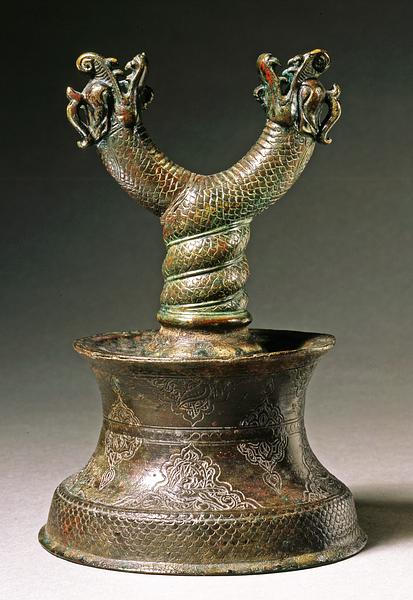Candlestick, cast and engraved bronze
Central Asia, Afghanistan or Iran; 15th century
H: 25.5; Diam: 17 cm
This double candlestick, its neck made up of two entwined dragons, seems on the basis of its shape, the engraved decoration, and the design of the dragons to be one of the oldest in its group. The type’s basic form presumably comes from Central Asia, from which it spread to the Iranian region in the late 15th and 16th century.
Dragons, which in Chinese and Turkish art mainly have a positive significance, are also found extensively in Timurid art. They appear on candlesticks like this one, serve as handles on cups and jugs, and often make up part of the hilts of swords and daggers.
Inv. no. 38/1982
Published in:
Spink & Son: Persian and Islamic art, London 1977, cat.no. 148, pp. 47-48;
Yanni Petsopoulos [ed.]: Tulips, arabesques and turbans: decorative arts from the Ottoman empire, London 1982, p. 39, fig. 15e;
Art from the World of Islam. 8th-18th century,, Louisiana, Humlebæk 1987, cat.no. 187;
Thomas W. Lentz and Glenn D. Lowry: Timur and the princely vision: Persian art and culture in the fifteenth century, Los Angeles County Museum of Art, Los Angeles 1989, cat.no. 122;
Kjeld von Folsach: Islamic art. The David Collection, Copenhagen 1990, cat.no. 346;
Kjeld von Folsach: Fabelvæsner fra Islams Verden, Davids Samling, København 1991, cat.no. 38;
Kjeld von Folsach, Torben Lundbæk and Peder Mortensen (eds.): Sultan, Shah and Great Mughal: the history and culture of the Islamic world, The National Museum, Copenhagen 1996, cat.no. 256;
Jill Tilden (ed.): First under heaven: the art of Asia, London 1997, p. 14, fig. 10;
Kjeld von Folsach: Art from the World of Islam in The David Collection, Copenhagen 2001, cat.no. 522;
Marthe Bernus Taylor [et al.]: L'etrange et le merveilleux en terres d'Islam, Réunion des Musées Nationaux, Paris 2001, cat.no. 78, pp. 112-113;
Abbas Daneshvari: Of serpents and dragons in Islamic art: an iconographical study, Costa Mesa 2011, pp. 70-71, pl. 24;
Mentioned in Michael Spink: “Dragons and arabesques: jade carving in Persia and Central Asia in the 15th century, The Woolf Jade Lecture” in Transactions of the Oriental Ceramic Society, 80, 2015-2016, p. 98, note 36;
